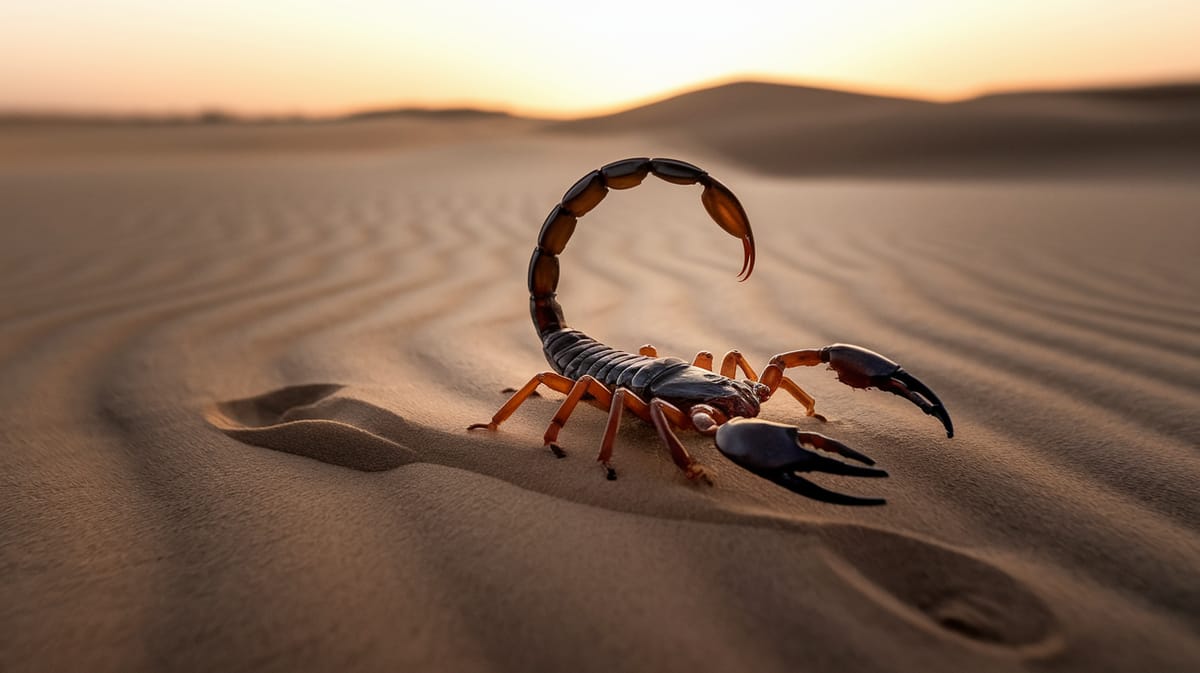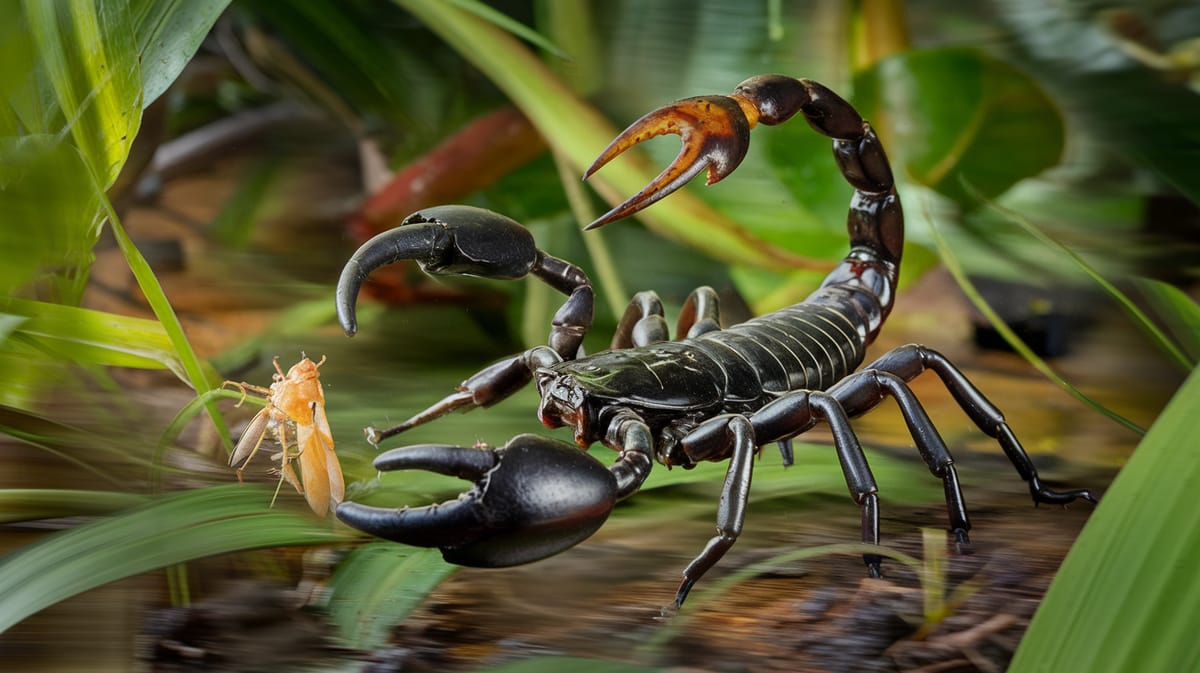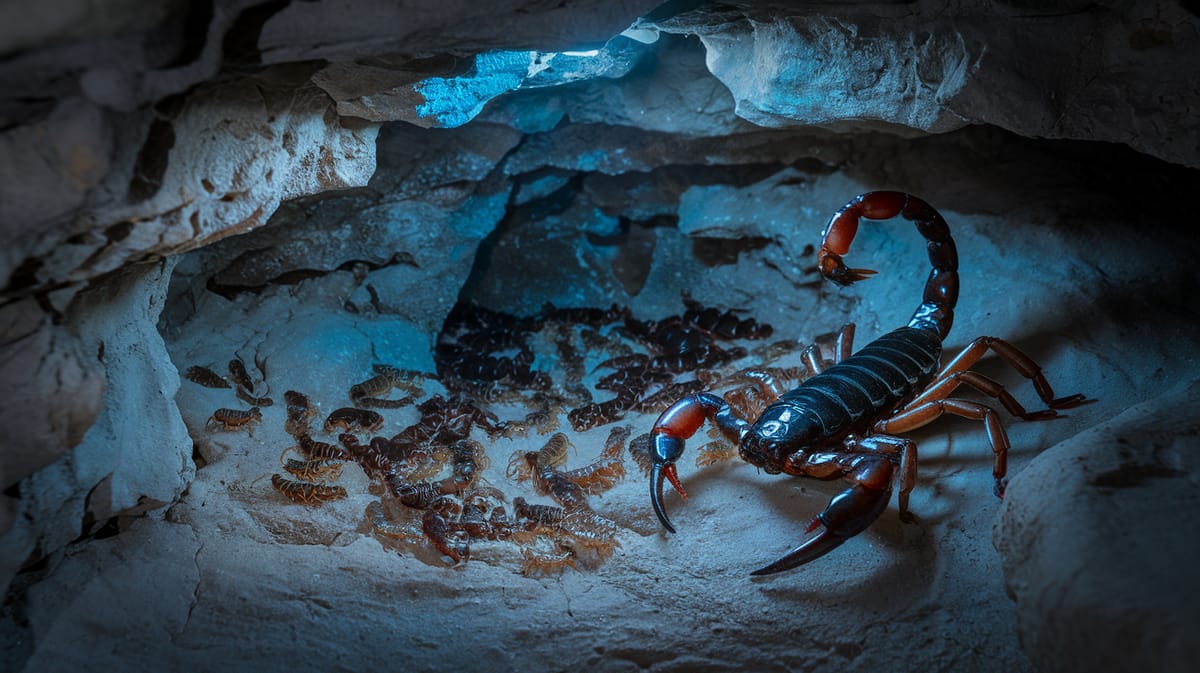Scorpion
Armed with a venomous sting and nocturnal instincts, the Scorpion thrives as a master hunter in harsh environments. It plays a vital role in controlling insect populations.

Key Insights at a Glance
Did You Know?
Taxonomy & Classification
Scorpions are formidable arachnids, known for their venomous stingers and nocturnal hunting skills, reflecting their evolutionary adaptation to diverse environments. Let's understand the evolutionary journey and classification of these remarkable predators.
Global Distribution
Scorpions thrive across all continents except Antarctica, with approximately 2,500 species adapted to various climates and terrains.
Ancient Survivors
Scorpions appeared over 430 million years ago, surviving mass extinctions due to their adaptable physiology and diverse habitats.
Lifecycle and Growth
A remarkable journey of transformation from Juvenile to Adult.
Juvenile
Juveniles ride on the mother's back, depending on her for protection and nourishment until they molt several times.
Adult
Adults are solitary predators with fully developed pincers and stingers, actively hunting and establishing territories.
Dietary Habits
A stealthy predator with keen hunting skills, it primarily feeds on insects and small vertebrates, adapting to available prey.
| DIET TYPE | DESCRIPTION |
|---|---|
| Primary Diet | Feeds mainly on insects like crickets, beetles, and spiders, capturing them with its pincers and venomous sting. |
| Secondary Diet | Consumes small vertebrates such as lizards and mice, supplementing its diet when conditions are favorable. |
| Occasional | Occasionally preys on other scorpions and small birds, exploiting rare opportunities for diverse nutrition. |

Behaviour and Adaptations
Discover the fascinating adaptations that make the Scorpion a resilient survivor in harsh environments.
Nocturnal Prowess
Scorpions hunt at night to avoid predators and capture prey efficiently.
Venomous Defense
Their venom deters predators and helps subdue prey effectively.
Desert Adaptation
Can withstand extreme temperatures and conserve water efficiently.
Ecosystem Impact
Scorpions play a crucial role in their habitat by maintaining ecological balance.
Natural Pest Control
Scorpions prey on various insects, helping control pest populations.
Food Chain Connector
They serve as prey for birds and mammals, linking food webs.
Soil Aeration
Burrowing scorpions improve soil structure and nutrient cycling.
Conservation Challenges
Understanding and addressing the major threats to Scorpion populations.
Habitat Loss
Urbanization and agriculture reduce natural habitats for scorpions significantly.
Climate Change
Altered temperatures and rainfall patterns disrupt scorpion habitats and breeding.
Illegal Collection
Over-collection for trade and pets threatens scorpion populations in the wild.
Frequently Asked Questions
How long do Scorpions live?
Scorpions typically live for 3 to 8 years. Some species may survive up to 25 years in favorable conditions. Their lifespan largely depends on environmental factors and predation.
What do Scorpions eat?
Scorpions are carnivorous and primarily feed on insects, spiders, and other small arthropods. They use their pincers to capture prey and their venomous sting to subdue it.
Are Scorpions poisonous?
Scorpions are venomous, not poisonous. They use venom to capture prey and defend themselves. Only about 25 of the 2,500 known species have venom potent enough to be dangerous to humans.
Are Scorpions endangered?
Most scorpion species are not endangered, but habitat loss and human activity threaten some. Conservation efforts focus on preserving habitats and understanding scorpion ecology to prevent potential endangerment.
What do Scorpions symbolize?
Scorpions often symbolize protection, transformation, and death in various cultures. They can represent danger or resilience due to their nocturnal nature and defensive abilities.
Do Scorpions bite?
Scorpions do not bite; they sting. They use their stinger, located on the end of their tail, to inject venom into prey or threats. Stings can be painful but are rarely fatal to humans.
What color are Scorpions?
Scorpions vary in color, ranging from brown, yellow, and black to greenish or reddish hues. Their coloration helps them camouflage in their environment, aiding in both hunting and evading predators.
Does a Scorpion have wings?
Scorpions do not have wings. They are arachnids, related to spiders, and have a pair of pincers, eight legs, and a segmented tail with a stinger, but no wings.
What does a Scorpion look like?
A scorpion has a distinctive appearance with a pair of large pincers, eight legs, and a long, segmented tail ending in a stinger. They vary in size and color but generally have a hard exoskeleton.
Is a Scorpion an insect?
Scorpions are not insects; they are arachnids, like spiders and ticks. Unlike insects, which have six legs and three body segments, scorpions have eight legs and two main body parts: the cephalothorax and abdomen.
Related Insects
Discover insects with similar characteristics to Scorpion - including shared habitats, diets, and taxonomic classifications
Share this profile
Help others discover Scorpion
